Photo

Photography by Anna-Elina Lahti
2K notes
·
View notes
Video
youtube
DAGADANA - Plywe kacza po Tysyni (Пливе́ ка́ча по Тиси́ні)
“Plywe kacza po Tysyni”/ “Пливе́ ка́ча по Тиси́ні”/ is a Lemko conscript song (according to some sources it comes from Zakarpattia). It has literary origins. According to the researcher Wasyl Sokol the original text was written by the Zakarpattian author and translator Wasyl Grendżoloju-Donski. The text employs an archaic trope: death, or passing into the spirit world, is juxtaposed with a duckling swimming across the river. This image had appeared earlier, eg., in Celtic and Ugro-Finnish epic poems (including the Finnish Kalevala by Elias Lönnrot). The song took on a new life and meaning during the Euromaidan protests in 2014. It first resounded at the funeral of the Belorussian Michail Żyznieuski. The favourite song of one of the first victims of the Ukrainian Spring, it was chosen for this occasion by friends and – to the surprise of many – it quickly achieved great popularity. Its new significance inspired a phenomenon as crowds sang it to commemorate all those who were killed in the Revolution. Later it became its unofficial hymn – performed as a tribute to the Euromaidan activists (the “Heavenly Hundred”) and the other heroes who gave and are still giving their lives in the war in East Ukraine. We brought this piece into the studio in April 2014 and wanted to express the pain and despair which filled our hearts at that time.
A duckling swims along the Tysa, A duckling swims along the Tysa. Dear mother, please don’t scold me, Dear mother, please don’t scold me. Now is not the time for scolding, Now is not the time for scolding. I don’t know where I’ll perish, I don’t know where I’ll perish. O, I will die in a foreign land, O, I will die in a foreign land. Who will dig my grave? Who will dig my grave?
Strangers will dig it for me, O strangers will dig it for me, Won’t you, mother, regret it? Won’t you, mother, regret it?
How can I not regret it, son? How can I not regret it, son? I carried you upon my heart, I carried you upon my heart, A duckling swims along the Tysa, A duckling swims along the Tysa.
14 notes
·
View notes
Text
today is your day, Winter Mother, and tonight is your night. let the snow fall and cover everything in white, let the harsh winds embrace us, and let the longest night bring us truths and revelations and confessions that change us in the most profound ways.
your reign will end, but now you are here, you freeze, you rule. hail Morana, Winter Mother, Queen of Nightmares, Lady of bitter truths and curses, Bringer of Change and Decay.
1K notes
·
View notes
Video
youtube
Vesnyanki (веснянки) are ritual songs of the East Slavs, sung in the rites of invoking the spring (весна). This song is an example from Ukraine. Ой, ти, соловейко, ти ранняя пташко, ти ранняя пташко, Ой, чого ж так рано з вирію вилітаєш, з вирію вилітаєш?
Ой, да ще по горах білі сніжки лежать, білі сніжки лежать. A ще по долинах цілі льодки стоять, цілі льодки стоять. Ой, да ще водиця не розливалася, не розливалася. Ой, да ще вербиця не розвивалася, не розвивалася.
Ой, а тії сніжки ніжками потопчу, ніжками потопчу, Ой, а тії льодки крилечками поб'ю, крилечками поб'ю, Ой, а ту вербицю дзьобиком розклюю, дзьобиком розклюю. _____________________________________________________________
Оh, you, nightingale you early bird, you early bird. Oh, why so early from Vyriy* you have flown away, you have flown away.
Oh, and still on the mountains white snow lies, white snow lies. And still in the valleys ice is whole, ice is whole. Oh, and still water didn’t flow, didn’t flow. Oh, and still willow didn’t sprout, didn’t sprout.
Oh, and that snow, with your legs you trample, with your legs you trample. Oh, and that ice, with your wings you strike, with your wings you strike. Oh, and that willow, with your beak you peck, with your beak you peck.
*Vyriy is name for otherworld in Slavic mythology, described as evergreen and warm place where birds fly for the winter, and where souls resides before the birth and after death.
285 notes
·
View notes
Text
Old Gods
when was the last time when you touched the earth?
lowered your head, bent your knees, buried your hands in the life giving grass and rich dirt? close your eyes, listen closely to the rustle of leaves, the song of the wind, the heartbeats of birds. feel the sun on your back, feel as it colours you in shimmers of gold. feel the life around you, never ending and never stopping, old voices singing the same hymn since the beginning of time.
take a deep breath. open your eyes.
you’ll see them.
3K notes
·
View notes
Note
How is ancestor veneration done in a slavic way?
How appropriate, with Christmas coming! Before I begin, let me note that my answer shall be a bit of everything - old and new practices, and traditions that are specifically Slavic as well as the ones that may have been adopted but now are widely practiced in this area of the world. Also, keep in mind that most of my knowledge and research is very Ukrainian area-based.
The short answer is, all the time.
The long one I would start with Christmas. Now, where I live the celebration starts on the 6th of January, on Christmas Eve. That is when the family has the holiday dinner, sharing kutia (which, as you may notice, shares not only the recipe with remembrance dinners, but also, to an extend, a situation) and other dishes - more importantly to this conversation, a dish and a glass with food and drink is set aside for ancestors who come to visit, and the dishes and pots after dinner are not washed, also for the sake of hungry spirits.
There are a few holidays that likewise include an element of ancestor veneration or a built around it altogether, such as, in the areas under Catholic influence, All Souls’ Day. If you look at the Orthodox calendar, which I am personally more familiar with, you will notice several dates that are called “батьківські суботи”, the “parents’ Saturdays”, which are days dedicated to prayers for the dead. During Radunitsa, people bring food and liquor to graveyards, joyously eat and drink in memory if the deceased. Around that time, candy is often left on graves, promptly gathered again by children. A person is remembered, with at least a drink to them, or a filled glass, a slice of bread, and a lit candle by a portrait, or, ideally, with a visit to the grave, on their birth and death day, the name day, and at large family gatherings.
One thing of note is that Christian and folk or pagan ways of remembrance differ. If in Christian ideal people calmly and hopefully pray for the soul to go to Heaven, the other path is to see to the soul’s being content. It means talking to them if you feel they are angered, feeding them, welcoming them - but also making sure a malicious or way too playful spirit does no harm. The first action taken is, of course, peaceful, but should that fail - well, the living have to live.
The continuity of the contact - for the belief is that people stay close to their family and community after death, - brings us to the subject of altars. As previously mentioned, many people, especially older ones, still have home altars which, among other items, include photographs of deceased relatives. Smaller ones, with only a photo, a glass of vodka, and a slice of bread on top of it, are common enough. Altars were present in homes of Kievan Rus, and, with how ancestor worship-based the belief of the people as a whole was and is, it is fair to assume that they often were dedicated to dead humans. One notable event related to remembering the dead is that of Olga of Kyiv’s feast on her husband’s grave, which ended up… well, to be a proof one is not to anger friendly-looking pagan ladies in a position of power.
Speaking of feasts, one notable celebratory, if such word is to be applied here, tradition is that of a tryzna. It is a complex process, consisting of sacrifices, games that imitate combat, and a feast. May or may not mean a fistfight with a certain mortality rate and getting wasted.
With the aid of ancestors so important (for example, there is a theory that Domovyk, the household spirit, is, in fact, an ancestor one), veneration can take a form of learning, gaining skills, and taking care of your home and family, as much as it can be sharing a meal with a photograph on a gravestone.
TL;DR: Make your ancestors proud and drunk.
392 notes
·
View notes
Photo









Veles
Are they not with you, those who went missing, those who perished in the mountains and found peace where the winds are dancing under the palm of your hand on the edge of bright morning?
167 notes
·
View notes
Photo









Veles
Are they not with you, those who went missing, those who perished in the mountains and found peace where the winds are dancing under the palm of your hand on the edge of bright morning?
167 notes
·
View notes
Photo
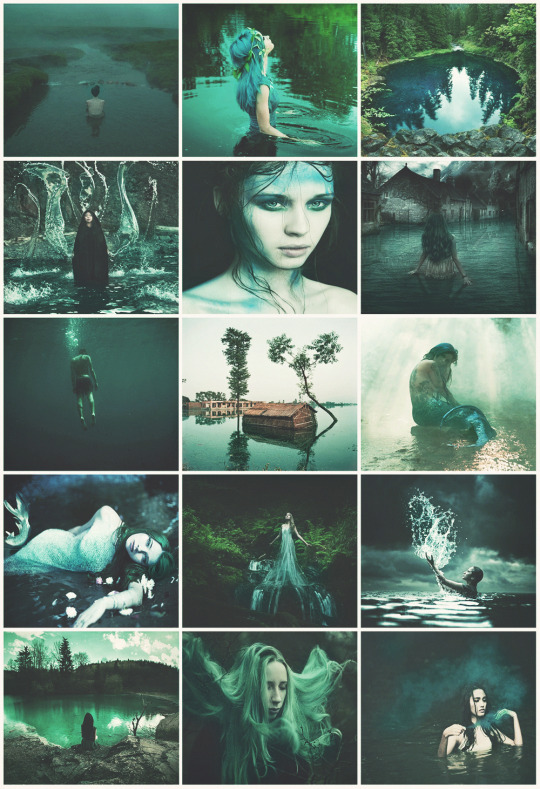
Știma Apelor aesthetic
Romanian folklore creatures series - V
Știma Apelor (Water Nymph) is, in the romanian mythology, a primitive freshwater divinity, responsible for aquatic stability and can cause both floods and drought. She presides over fountains, wells, springs, streams, brooks, rivers, lakes and other bodies of freshwater and she is described as a beautiful wild woman, with long green-blue hair and alluring eyes, half human-half fish while living in the water.
When angered by humans, Știma comes out of the water with streams of water behind her, flooding everything on her way, villages, fields, people and animals. After she calms down, she returns to her home. She can also take the appearance of a young beautiful woman with long hair and seductive eyes, which attracts the boys to drown them.
1K notes
·
View notes
Photo

Iele aesthetic
Romanian folklore creatures series - IV
The Iele are feminine mythical creatures in Romanian mythology, often described as virgin fairies with great seductive power over men, with magic skills and attributes. They live in the sky, in forests, on isolated mountain cliffs and in marshes, and reported to have been seen bathing in the springs or at crossroads. They mostly appear at night by moonlight, as dancing, in secluded areas such as glades, the tops of maple trees or abandoned fireplaces, dancing naked or in white dresses and with bells on their ankles. The place where they had danced would after remain carbonized.
They gather in groups in the air, where they can fly without wings; they can travel with incredible speeds, either on their own, or with chariots of fire. The Iele appear sometimes with bodies, at other times only as immaterial spirits.
They are not generally considered evil genii: they resort to revenge only when they are provoked, offended, seen while they dance, when people step on the trodden ground left behind by their dance, sleep under a tree which the Iele consider as their property, drink from the springs or wells used by them.
824 notes
·
View notes
Photo

Sʟᴏᴠᴇɴᴇ Fᴏʟᴋ ᴀɴᴅ Fᴀɪʀʏ Tᴀʟᴇs
1•∞ Bela kača s kronico
The White Serpent with a Small Crown
There was once a peasant woman and she had children. She would go work in the fields and leave the children at home, giving them a bowl of milk to keep their hunger away while she was gone. They always ate it all and the mother praised them for their diligence. The children said, “Oh, but we’re not eating alone, there’s a nice birdie that comes to eat with us, too.” The mother thought that some cat comes to eat with the children. Still, she found it odd that the children were talking about a nice white birdie. She wanted to see for herself what it really was. She hid in the house, set up the milk as usual and waited. Soon, a white serpent with a beautiful crown on its head slithered out from beneath the table and into the arms of the youngest child. The mother was petrified. But the children stroked and caressed the nice birdie. When the serpent ate its fill, it shook the crown from its head and returned to the hole again. As soon as the serpent disappeared, mother jumped into the foyer and took the children to safety; of course, she did not forget to take the crown as well. She put it in the chest where they kept the yarn. Grandfather would wind the yarn in winter. He’d wind it all winter, but there was no end to it. The woman thought, “Whatever could it be? Perhaps the crown has such a power?” The crown was thus put away and the yarn wound up. It was then put in the grain. They’d measure and measure the grain, but the granary never emptied. So the crown was put in one place and then another and soon the house recovered and was doing so well that it was the richest in the village. And the crown remained with them, so long as the kin that treated the white serpent well lived there.
Illustration by Ančka Gošnik Godec, Slovene original below.
Czytaj dalej
420 notes
·
View notes
Photo
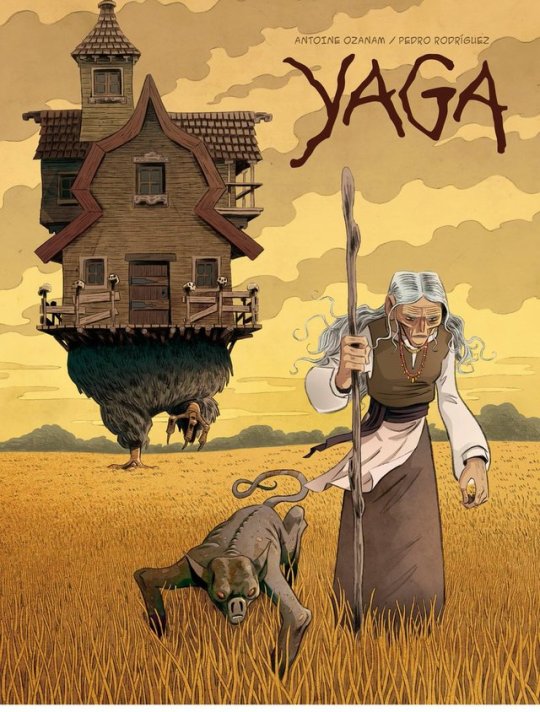
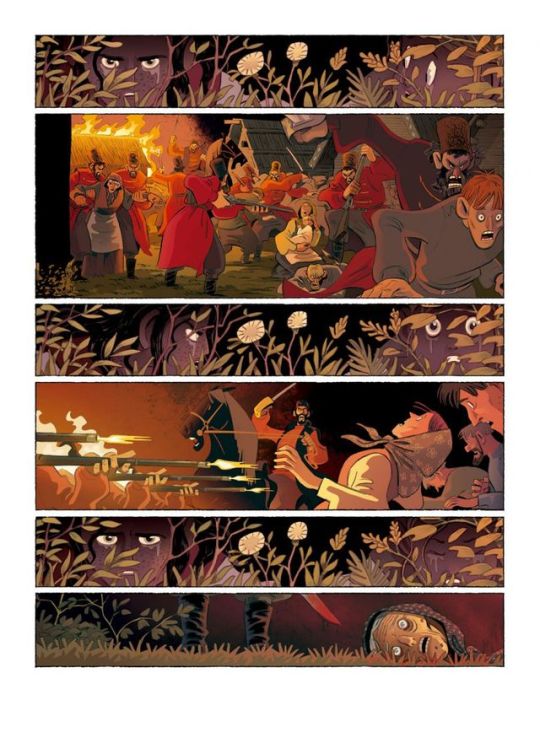
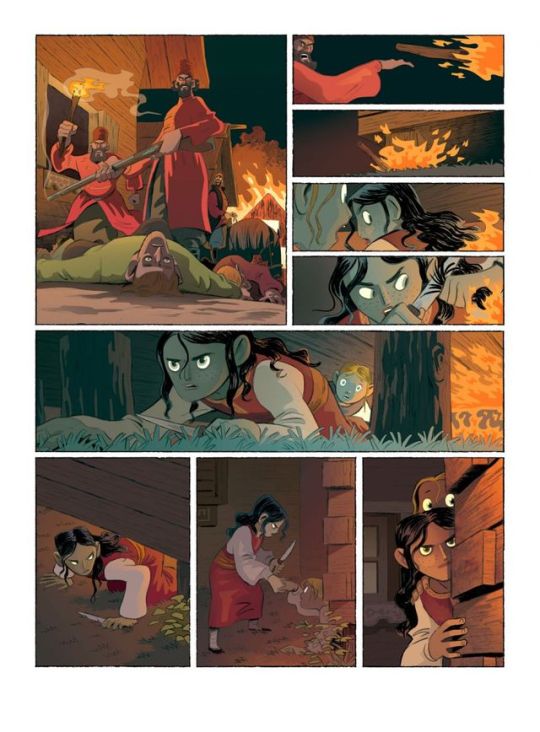
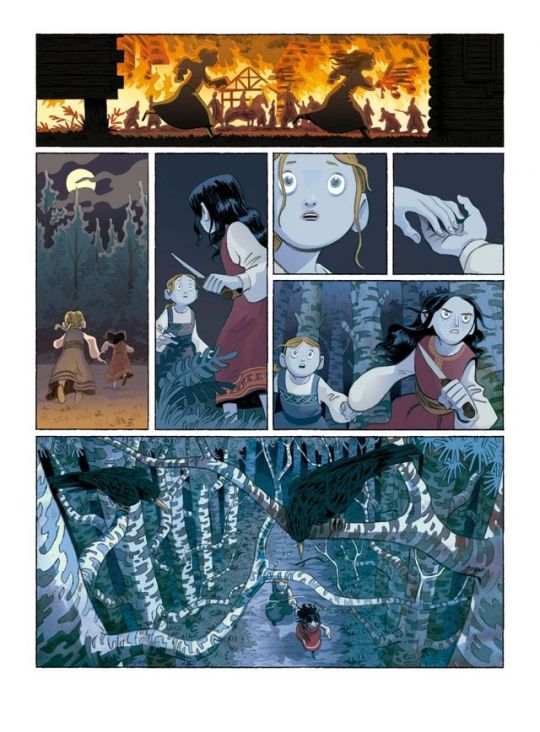

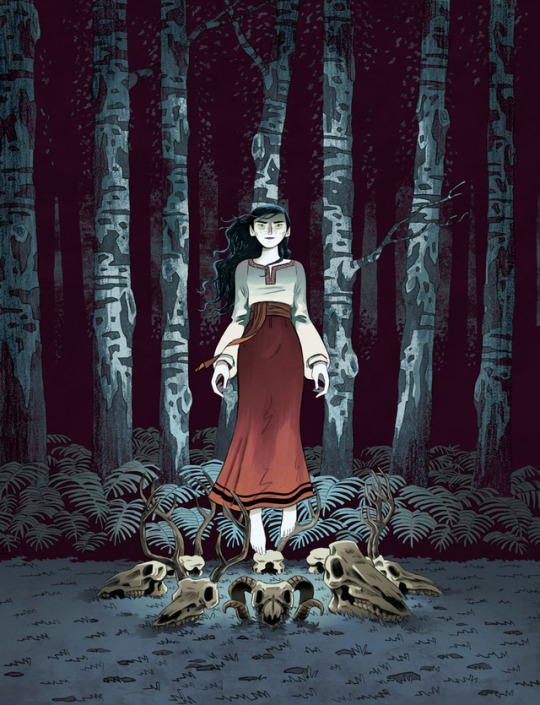
Comic Book Crowdfunding:
YAGA | Spaceman Project
Since the beginning of times, all children have heard tales of the terrible Baba Yaga. The legendary Russian witch who walks around with a magic cauldron and often accompanied by chicken legs in her house. It is said that she is the incarnation of evil, that she’s a disciple of Satan…but none of us are born evil. This is the story of a girl abandoned to her luck, who will have to turn into a monster who crept up on children in the eternal stories of Baba Yaga.
This project is available in: Spanish, English, French and Italian.
Expected date of publication: may 2019
Campaign type: All or nothing
14K notes
·
View notes
Text
Personal Holiday Calendar: Winter
The holidays I celebrate are from both Norse and Hungarian traditions. The year is divided into Winter (winter + spring) and Summer (summer + autumn).
Winternights
The Saturday between 11Oct and 17Oct
Celebrates the bounty of the harvest and honors Freya and the fertility and protective spirits called Disir (often seen as our female ancestors). Give glory to Freya and pour a libation of ale, milk, or mead into the soil as an offering to the Disir and the Earth itself.
Feast of the Dead
Late October to early November
Mixture of Halloween and more solemn ancestor veneration. Focuses on the return of ancestors and other spirits. End of the growing season.
Harvest Celebrations
Late November
Several family-oriented days (including the US Thanksgiving) centering around gratitude for the last of the harvest. At this point, native plant species are dormant for the winter and migratory birds have passed.
Green Sunday
1st week of December
Copper Sunday
2nd week of December
Silver Sunday
3rd week of December
Gold Sunday
4th week of December
Mini-celebrations in anticipation of Karascunt and the Rough Nights. Reference Hadúr, Szélkirály, and Napkirály.
Karascunt
Winter solstice
Festival full of fire, drink, and merriment to celebrate Csodaszarvas carrying the sun over the river to begin the year anew and overcome the darkness.
Bertchten Day
January 5/6
End of the Rough Nights and start of the new year. The sun overcomes the darkness and the light continues to grow in strength. Also known as the 12th Night. Honors Lutzl, though she is associated with all 12 of the Rough Nights.
Day of the Bear/Barri
February 2
Midwinter celebration in anticipation of the season's end. The Bear awakes and brings the first hints of life and hope. Spring cleaning and purification, and winter expulsion begins. Honors Szélkirály.
Fertility festival, the time to plant seeds indoors. Celebrate the wooing of Gerd by Ingvi Freyr.
Zöldágjárás
Mid-late March
Initial bits of greenery brought inside to continue the purification process. Boughs of greenery are formed into arches and wreaths, and boys splash water on girls, and birds migrate back at this time.
Spring Equinox
March 20
Beginning of the season of rebirth. Today we honor Frigg, Freyja, and Nerthus with a blót and a feast. Pour a libation and celebrate the rebirth of nature.
Walpurgisnacht
April 30
Reflect on Freya, Hel, Ördög and Frigga as the repository of the glorious dead. Winter expulsion ends, compelling ghosts and ancestors back to sleep. Most migratory birds have returned and begun their breeding season.
23 notes
·
View notes
Photo

Stribog (Стрибог), in the Slavic pantheon, is the god and spirit of the winds, sky and air; he is said to be the ancestor (grandfather) of the winds of the eight directions.
403 notes
·
View notes
Photo

Falling Stars, Mihály Zichy
170 notes
·
View notes

